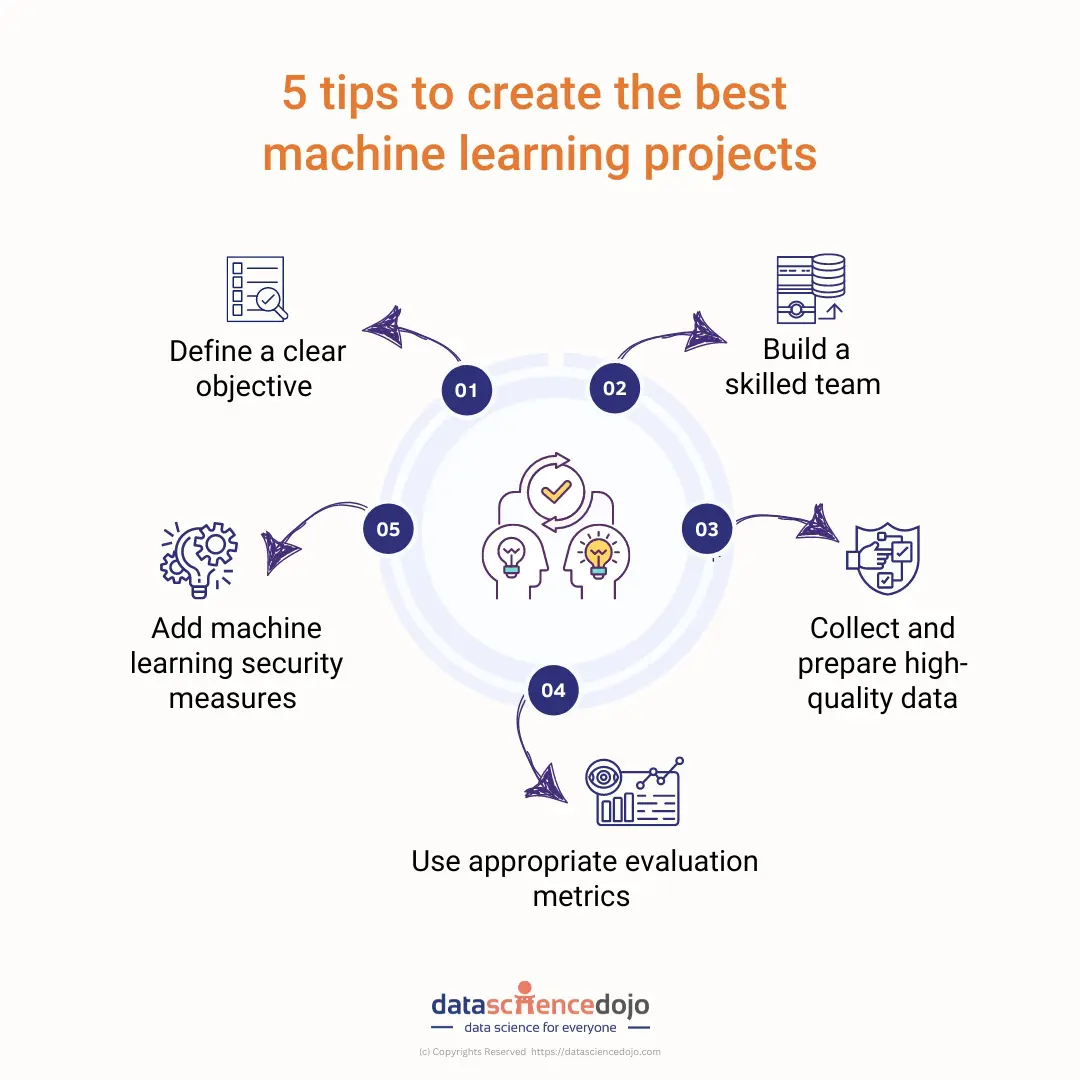Machine learning is the way of the future. Discover the importance of data collection, finding the right skill sets, performance evaluation, and security measures to optimize your next machine learning project.
Machine learning has the potential to transform industries and solve a wide range of problems, from predicting customer behavior to diagnosing diseases.

However, developing successful machine learning projects requires careful planning and execution.
Why? Because it’s easy to hit roadblocks, like finding suitable applications of machine learning, getting access to the data, and having the right technical skills to make a good model.
But don’t fret. Whether this is your first machine-learning project or you’re an expert in the field, these tips will help you build machine-learning projects that achieve your goals and drive a meaningful impact for your organization.

Let’s dive in.
1. Define a clear objective
Before starting a machine-learning project, you must clearly understand the problem you are trying to solve and what kind of machine learning task is required.
It may sound obvious, but the goal of machine learning isn’t simply “make things better.” Instead, you need a specific objective to focus your efforts on, such as improving customer satisfaction or reducing churn.
Defining a clear objective for a machine learning project keeps your team on the straight and narrow. With a specific goal in mind, you can avoid wasting time and resources on tasks that aren’t directly related to your desired objective.
Having a well-documented objective can also serve as a reference point for decision-making, helping to guide actions that are likely to contribute to achieving the desired outcome.
Without a clear vision for your project, it can be difficult for stakeholders to jump on the bandwagon — and even more difficult for them to know when you’ve achieved your goals.
2. Build a team with the proper skill sets
The success of your project depends on the skills of your team. And the best teams are cross-functional, with members from different areas within your organization.

Your team mix should include the following:
- Data scientists who can apply ML techniques.
- Engineers who understand computer hardware.
- Software developers who can design software applications.
You can create machine learning training programs within your organization (like Amazon does) or hire specifically for someone within this area of expertise.
Using LinkedIn to find candidates is a great place to start, but remember to post on a recruitment platform like Salarship because you never know where hidden talent might pop up.
Ideally, you should also have someone familiar with the business objectives and can communicate them effectively to stakeholders.
This person should be able to explain why it’s essential for your company to leverage machine learning — and why those services are better than manual processes or existing technology solutions.
3. Collect and prepare high-quality data
The saying “garbage in, garbage out” goes with machine learning, as peanut butter goes with jelly. An insufficient data set will result in a poor model and an inaccurate output.
Machine learning models are only as good as the data they’re trained on. So, collecting a large and diverse dataset that accurately represents the problem you are trying to solve is critical.
You should carefully pre-process and clean the data to ensure it is in a suitable format for training the model. Your machine learning model may draw incorrect conclusions from the underlying dataset if the data is incomplete, inaccurate, or inconsistent.
Here are some helpful reminders for improving the formatting and organization of your data:
- Use consistent formatting for date fields, such as changing all dates to the MM/DD/YYYY format.
- Check for duplicates and remove any identical values within a row or column.
- Remove any empty rows, cells, or other data that isn’t relevant or useful for your database.
- Reorder columns to make them more logical and user-friendly, such as placing first names before last names when importing contact information.
- Consider creating a new column for calculations to help prevent formulas from being overwritten when adding new data to the database.
Properly training your model from the ground up is the key to a successful machine learning project, especially if you want to sell your business or bring in new investors later.
4. Use appropriate evaluation metrics
Evaluating your model’s performance is nearly impossible without establishing the proper metrics to measure the results.
There are various metrics to assess the performance of a machine learning model. Still, the appropriate metric will depend on the specific task and the characteristics of your data input, broken down into two categories: classification and regression metrics.
Classification metrics
Some standard evaluation metrics that fall into the classification category include:
- Accuracy – The proportion of correct predictions made by the model.
- Precision – The proportion of true positive predictions made by the model out of all positive predictions.
- Recall – The proportion of true positive predictions made by the model out of all positive cases.
- F1 score – The harmonic mean of precision and recall.
Regression metrics
And on the other hand, here are a few regression metrics:
- Mean absolute error (MAE) – The average difference between predicted and true values.
- Mean squared error (MSE) – The average of the squared differences between predicted and true values.
- Root mean squared error (RMSE) – The square root of the MSE.
- R-squared – The proportion of variance in the true values explained by the model.
Using the wrong evaluation metrics can drain resources, especially on a project that isn’t successful, which is frustrating for all stakeholders involved.
5. Add machine learning security measures
Adding AI and ML projects into your core business operations introduces new security risks since bad actors are always searching for new ways to access sensitive information.
Protect your project against malicious activity using a web application firewall (WAF).
A WAF keeps track of and stops unwanted traffic to a web application used for data collection. Additionally, it protects against common web-based attacks, such as SQL injection and cross-site scripting.

Another way to enhance the security of your machine learning projects is to regularly check and audit the model to detect and address any security vulnerabilities that may arise.
With access control, you can ensure that only authorized individuals can access the model, and the data it processes can prevent model poisoning and insider threats.
Cybersecurity isn’t a set-it-and-forget-it task. Instead, add proactive measures at every project stage, from data collection and storage to the model’s development and deployment.
Wrapping up
Creating a machine learning project from the ground up might not be a short journey.
But with a clear objective, high-quality training data, and the right team in place, you are on the right path to success in building a machine-learning project that delivers meaningful results.
As you work towards your end goal, keep an open mind to finding creative and effective solutions to any machine-learning challenges you encounter.
Written by Kelly Moser


